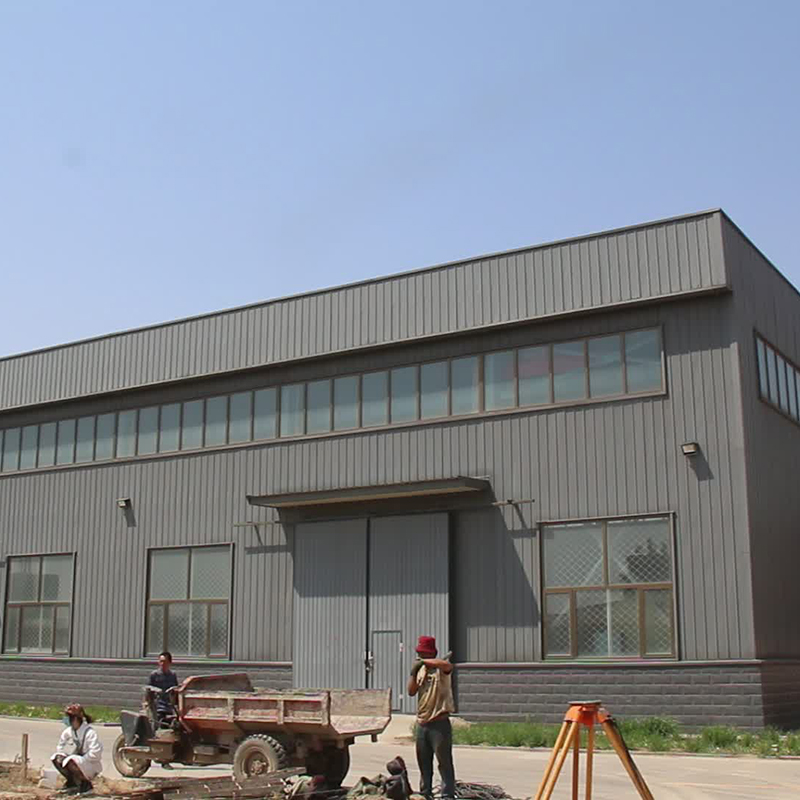The specific construction process of general steel structure canopy, each step is repeatedly confirmed by the editor, designer and construction director, hoping to give the friend who wants to be the steel structure canopy as a reference. Of course, the specific construction process of different types of steel structure canopy is different.Let’s take a look at the detailed construction process of general steel structure canopy.
1.Processing preparation and blanking
According to the construction drawing lofting, the welding shrinkage and machining allowance should be reserved during setting out and marking off, and the template should be made according to the lofting.Steel correction: steel must be corrected before blanking, and the deviation value after correction shall not exceed the allowable deviation value specified in the specification, so as to ensure the quality of blanking.The hot working section steel is hot processed first, and then the hole is numbered after cooling.Steel plate embedded parts and other parts are cut, drilled and sprayed with anti-corrosion paint.
2.Surveying and setting out
According to the elevation datum line of civil engineering, measure the elevation center line of embedded parts, and check the elevation deviation, left and right deviation of embedded parts.Sort out the results and determine the adjustment and treatment scheme for the separation of embedded parts.Draw ink line along the outer edge of the floor to determine the top elevation line of embedded parts.
3.Installation and treatment of embedded parts
Locate the installation position of embedded parts and drill for installation.The position of embedded parts shall be accurate and firm.The elevation deviation is not more than 9mm, and the left and right displacement is not more than 20mm.
4.Installation and welding of suspension arm
The suspension arm is installed by welding. It is necessary to check the welding nodes and adjust the design slope of the suspension arm to ensure the accuracy.After the suspension arm on the other side is accurate, install the other side suspension arm and spot weld it after it is in place accurately.Then take the two suspension arms as the benchmark, pull out the highest and lowest elevation lines of the suspension arms, and weld the remaining suspension arms one by one.And welded seamless steel pipe.When the section steel needs to be lengthened, the joint shall be welded first and straightened.When using the section steel joint, in order to make the joint section steel close to the embedded parts of the steel plate, the corner should be removed according to the design requirements.For butt welds, run on plates shall be welded at both ends of the weld, and the material and type of wave mouth shall be the same as those of the weldments. After welding, gas cutting shall be carried out to cut off and grind flat.
5.Calibration test
After the suspension arm is installed, first check the quality of the on-site connecting parts.The installation quality of suspension arm mainly includes the non perpendicularity of the vertical surface of the suspension arm; the side sagging of the vertical surface of the suspension arm under compression; and the suspension arm slope.Ensure that the suspension arm meets the design stress state and overall stability requirements.
6.Connecting stressed cables
Locate the datum line and elevation line of the tie rod, install the embedded parts as required, and weld the railing.
7.Installation and welding of stainless steel glass claw
According to the design size, the vertical and horizontal lines and the design elevation are ejected, the fixture is used to clamp, and the positioning spot welding is carried out. After the assembly, the glass claw base is welded.
8.Anti rust painting treatment
The slag and spatter shall be removed, and the surface of stainless steel parts shall be sprayed with white paint for multiple times of antirust painting.The thickness of coating and film shall meet the requirements of design or construction specification.The paint on the inner side of the steel shall not be missed.
9.Processing, manufacturing and installation of laminated glass
According to the design requirements, combined with the measured size to determine the glass size, as well as the horizontal and vertical position, the manufacturer processing and manufacturing.Install the stainless steel glass claw, adjust the glass after temporary fixing, and adjust the standard horizontal, vertical and plane.The deviation shall not exceed the specified deviation.
10.Adjustment test
The point type glass shall be inspected for overall adjustment, and the adjustment standard shall be horizontal, vertical and flat.The deviation shall not exceed the specified deviation.
11.Glue up and down
Fully clean the gap between glass, there should be no water, oil, paint, rust, cement mortar, dust, etc.Clean the bonding surface thoroughly and dry it.To adjust the depth of the seam, avoid gluing on three sides.Paste protective tape on both sides of the seam to protect the glass from contamination.Apply the sealant up and down at the same time. After glue injection, smooth the surface of the sealant joint and remove the excess glue.After glue injection, tear off the protective paper and wipe the glass with solvent if necessary.Before the glue is completely hardened, do not get dust and scratches.
12.Repair inspection
Local repair inspection.
13.Glass cleaning
After confirming that there are no problems in each part, clean the glass dust as a whole, wipe the glass with solvent if necessary, and wait for acceptance.
Post time: Jul-10-2020

